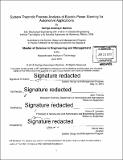System theoretic process analysis of electric power steering for automotive applications
Author(s)
Sotomayor Martínez, Rodrigo
DownloadFull printable version (13.03Mb)
Other Contributors
System Design and Management Program.
Advisor
John Thomas and Nancy G. Leveson.
Terms of use
Metadata
Show full item recordAbstract
The automotive industry is constantly challenged with meeting and exceeding customer expectations while reducing time to market of new products in order to remain competitive. Providing new features and functionality into vehicles for customer satisfaction is becoming more challenging and driving design complexity to a higher level. Although traditional methods of Product Development Failure Mode identification such as FMEA (Failure Mode and Effect Analysis) or FTA (Fault Three Analysis) have been used to analyze failures in automotive systems, there are limitations when it comes to design errors, flawed requirements, human factors implications, and component interaction accidents in which all components operated as required but the system behavior was not as expected. In order to determine if there is room for improvement in current automotive product development process, this thesis applies Dr. Nancy Leveson's Systems-Theoretic Process Analysis (STPA) technique to compare and contrast with a Failure Modes and Effects Analysis (FMEA) approach as used in the automotive industry through a case study. A formal method of comparing results is proposed. This study found limitations with FMEA in terms of identifying unsafe interactions between systems, anticipating human error and other behaviors dependent on human interaction, identifying engineering design flaws, and producing requirements. STPA was able to find causes that had a direct relationship with those found in FMEA while also finding a portion of causes related to a higher level of abstraction of those in FMEA. STPA also found a subset of causes that FMEA was not able to find, which relate mainly to engineering design flaws and system interaction.
Description
Thesis: S.M. in Engineering and Management, Massachusetts Institute of Technology, Engineering Systems Division, 2015. Cataloged from PDF version of thesis. Includes bibliographical references (pages 101-103).
Date issued
2015Department
System Design and Management Program.; Massachusetts Institute of Technology. Engineering Systems DivisionPublisher
Massachusetts Institute of Technology
Keywords
Engineering Systems Division., System Design and Management Program.